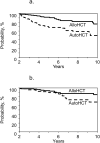Reduced-Intensity Allografting as First Transplantation Approach in Relapsed/Refractory Grades One and Two Follicular Lymphoma Provides Improved Outcomes in Long-Term Survivors
- PMID: 26253007
- PMCID: PMC4639453
- DOI: 10.1016/j.bbmt.2015.07.028
Reduced-Intensity Allografting as First Transplantation Approach in Relapsed/Refractory Grades One and Two Follicular Lymphoma Provides Improved Outcomes in Long-Term Survivors
Abstract
This study was conducted to compare long-term outcomes in patients with refractory/relapsed grades 1 and 2 follicular lymphoma (FL) after allogeneic (allo) versus autologous (auto) hematopoietic cell transplantation (HCT) in the rituximab era. Adult patients with relapsed/refractory grades 1 and 2 FL undergoing first reduced-intensity allo-HCT or first autograft during 2000 to 2012 were evaluated. A total of 518 rituximab-treated patients were included. Allo-HCT patients were younger and more heavily pretreated, and more patients had advanced stage and chemoresistant disease. The 5-year adjusted probabilities, comparing auto-HCT versus allo-HCT groups for nonrelapse mortality (NRM) were 5% versus 26% (P < .0001); relapse/progression: 54% versus 20% (P < .0001); progression-free survival (PFS): 41% versus 58% (P < .001), and overall survival (OS): 74% versus 66% (P = .05). Auto-HCT was associated with a higher risk of relapse/progression beyond 5 months after HCT (relative risk [RR], 4.4; P < .0001) and worse PFS (RR, 2.9; P < .0001) beyond 11 months after HCT. In the first 24 months after HCT, auto-HCT was associated with improved OS (RR, .41; P < .0001), but beyond 24 months, it was associated with inferior OS (RR, 2.2; P = .006). A landmark analysis of patients alive and progression-free at 2 years after HCT confirmed these observations, showing no difference in further NRM between both groups, but there was significantly higher risk of relapse/progression (RR, 7.3; P < .0001) and inferior PFS (RR, 3.2; P < .0001) and OS (RR, 2.1; P = .04) after auto-HCT. The 10-year cumulative incidences of second hematological malignancies after allo-HCT and auto-HCT were 0% and 7%, respectively. Auto-HCT and reduced-intensity-conditioned allo-HCT as first transplantation approach can provide durable disease control in grades 1 and 2 FL patients. Continued disease relapse risk after auto-HCT translates into improved PFS and OS after allo-HCT in long-term survivors.
Keywords: Autologous hematopoietic cell transplantation; Grade 1 and 2 follicular lymphoma; Long-time survival; Reduced-intensity allogeneic hematopoietic cell transplantation.
Copyright © 2015 American Society for Blood and Marrow Transplantation. Published by Elsevier Inc. All rights reserved.
Figures


References
-
- Montoto S, Canals C, Rohatiner AZ, et al. Long-term follow-up of high-dose treatment with autologous haematopoietic progenitor cell support in 693 patients with follicular lymphoma: an EBMT registry study. Leukaemia. 2007;21:2324–2331. - PubMed
-
- Rohatiner AZ, Nadler L, Davies AJ, et al. Myeloablative therapy with autologous bone marrow transplantation for follicular lymphoma at the time of second or subsequent remission: longterm follow-up. J Clin Oncol. 2007;25:2554–2559. - PubMed
-
- Passweg JR, Baldomero H, Gratwohl A, et al. The EBMT activity survey: 1990-2010. Bone Marrow Transplant. 2012;47:906–923. - PubMed
-
- Schouten HC, Qian W, Kvaloy S, et al. High-dose therapy improves progression-free survival and survival in relapsed follicular non-Hodgkin's lymphoma: results from the randomized European CUP trial. J Clin Oncol. 2003;21:3918–3927. - PubMed
Publication types
MeSH terms
Substances
Grants and funding
LinkOut - more resources
Full Text Sources
Other Literature Sources

